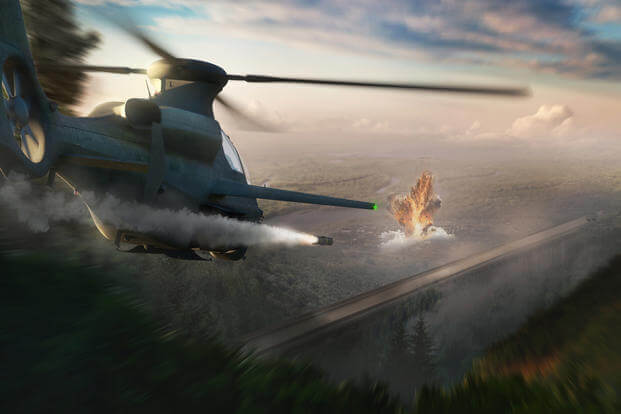U.S. Army modernization officials have asked aviation firms for ideas on equipping the service's future scout helicopter with mission systems such as a sleek 20mm cannon and advanced technology for optionally-manned flight.
The April 13 request for information comes on the heels of the Army's selection of the Bell Textron Inc. 360 Invictus and Lockheed Martin's Sikorsky Raider X in late March for the final prototyping stage of the Future Attack Reconnaissance Aircraft, or FARA. The aircraft is being designed under the Future Vertical Lift effort to replace the retired OH-58 Kiowa and some AH-64 Apache helicopters.
FVL is one of the Army's top modernization priorities under a new strategy the service launched in 2017, with the goal of replacing most major combat platforms beginning in 2028.
Program officials are seeking information on a range of capabilities to give FARA pilots an edge as they penetrate enemy air defense networks, flying far faster than current Army aircraft, service officials say.
Related: Down to 2: Aircraft Will Compete to Replace the Army's Apache, Kiowa
Interested companies have until May 15 to submit ideas for equipping FARA with navigational capabilities such as "Digital Terrain Elevation Data (DTED) assisted visual-based solutions for aerial navigation in GPS denied environments," according to the request for information.
FARA officials are also interested in solutions and software applications that support "supervised autonomy/optionally-manned flight," as well as technology to give pilots decision-aiding tools, such as voice activation for some systems, and other cueing capabilities, according to the RFI.
Pilot heads-up or helmet-mounted displays will have to be high-definition, color-capable, and compatible with a night-vision device. The FARA will also be equipped with a 20mm cannon capable of providing a maximum of 360 degrees of azimuthal coverage and 60 degrees of elevation coverage, according to the RFI.
The Army is "particularly interested" in solutions that generate "minimal aerodynamic interference" to reduce drag, as the aircraft is being designed to fly at speeds of 200 miles per hour or more.
Lockheed's original Raider prototype has been flying since 2018 and has surpassed speeds of 200 knots, according to Sikorsky representatives. It is currently being scaled into the Raider X, which will be 20% larger for the FARA program.
Bell officials maintain that the 360 Invictus helicopter should be able to fly at speeds greater than 180 knots true airspeed, or more than 200 miles per hour.
The Army also wants the mission systems designed for the FARA to be capable integration into the Future Long Range Assault Aircraft, or FLRAA, also being developed under FVL to replace the UH-60 Black Hawk helicopter.
In mid-March, Army aviation officials selected Bell Textron Inc. and Sikorsky Aircraft Corp. to continue into the FLRAA Competitive Demonstration and Risk Reduction phase of the program, which is expected to last until 2022, the year the service plans to choose one vendor to build the Black Hawk replacement.
Bell Textron's V-280 Valor tiltrotor helicopter prototype and the Sikorsky-Boeing SB-1 coaxial-rotor Defiant helicopter prototype were developed under the Army's Joint Multi Role Technology Demonstrator (JMR-TD) effort.
The Army plans to hold an industry day for both FARA and FLRAA efforts in Huntsville, Alabama this summer on a date to be announced in the future, according to the RFI.
-- Matthew Cox can be reached at matthew.cox@military.com.
Read More: These 2 Futuristic Aircraft Will Compete to Replace the Army's Black Hawk













